Get a 7-day fully-featured trial.
It's easy to upload multiple files and URLs with Speak Ai.
Create an account and import your file from anywhere - your computer, a YouTube URL or any publicly accessible link.
The first 30 minutes are free and you also get access to our premium features.
Speak's powerful automated transcription and analysis will produce a transcript that can be up to 95% accurate depending on the quality of the uploaded audio.
As an added bonus you get advanced AI text and speech analysis that gives more meaning to your transcript.
We have an easy-to-use, built-in transcript editor that is stitched to your audio file. This means you can interact with the transcript and go to specific moments in your file.
If you'd rather not spend time editing your transcripts you can order professional human transcription with just a single click.
Once you're satisfied with the quality of your MP4 to text transcript, you can export it in a variety of formats including TXT, PDF, DOCX, SRT and more.
Are you looking for automatic transcription? You have come to the right place!
If you Google transcription, you will find transcription software to help you transcribe audio and video into text. Some solutions work much better than others.
Using Speak, you can get words transcribed into text instantly and automatically through a simple software interface. Speak is also very competitive in pricing and offers you the ability to pay as you go for a 7-day trial so you can figure out the best options after the trial is complete.
You may be looking to transcribe audio to text or video to text. Speak does automatic transcription of both audio and video.
In your search for the best transcription solution, you may also be finding transcription APIs available like Amazon Transcribe, Google Speech-to-Text, Microsoft Azure Speech-To-Text and more. Speak also has transcription APIs and those are valuable if you are a developer looking to integrate transcription into your workflow and products.
However, if you are not a developer, finding a transcription solution that gives you easy-to-use software is crucial and that is where Speak excels above and beyond.
Transcription is the process of converting audio or video content into written text. It is used in a wide range of industries, such as legal, medical, educational, business, research, and entertainment. Transcription services can be used to turn audio recordings, lectures, podcasts, interviews, videos, and other speech-based content into written documents.
Transcription is important for numerous reasons. It enables people to capture and store information in a way that can be easily accessed and understood. It can be a powerful tool for increasing efficiency, accuracy, and accessibility.
Additionally, transcription services can be used to create educational materials, make data easier to search and analyze, and archive important conversations.
Transcription services come in various forms, depending on the type of content being transcribed. Audio transcription services convert audio recordings into written documents, while video transcription services convert video content into written documents. Legal transcription services are used to convert court proceedings, depositions, and other legal documents into written documents. Medical transcription services are used to convert medical records, doctor's notes, and other medical documents into written documents.
Transcription services offer a number of advantages. They can save time and money by eliminating the need to manually transcribe content. They can also improve the accuracy and clarity of written documents.
Additionally, transcription services can be used to make data easier to search and analyze, as well as to create educational materials. Finally, transcription services can help increase accessibility and provide a higher level of accuracy and clarity to archived documents.
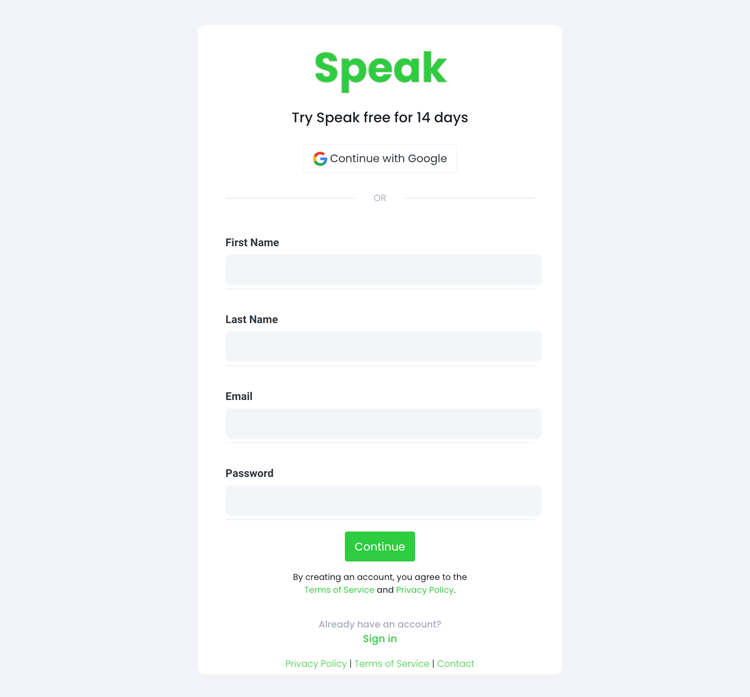
To start your transcription, you first need to create a Speak account. No worries, this is super easy to do!
Our team is happy to give you a 7-day trial with 30 minutes of free audio and video transcription included.
To sign up for Speak and start your transcription, visit the Speak app register page here.
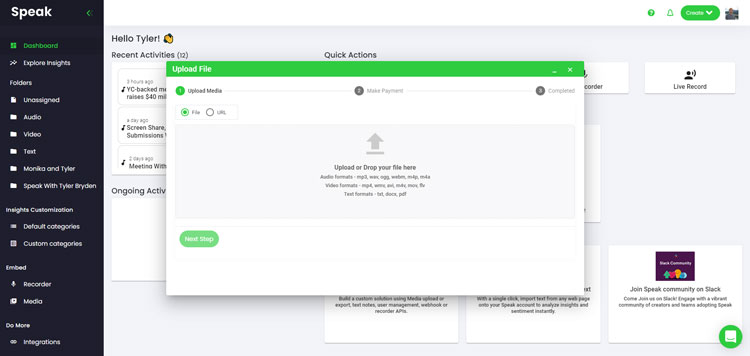
We typically recommend MP4s for video or MP3s for audio.
However, we accept a range of audio and video file types. Once you upload your file all you have to do is select "" from the language dropdown menu to automatically transcribe in .
You can upload your file for transcription in several ways using Speak:
You can also upload media to Speak through a publicly available URL.
As long as the file type extension is available at the end of the URL you will have no problem importing your recording for automatic transcription and analysis.
Speak is compatible with YouTube videos. All you have to do is copy the URL of the YouTube video (for example, https://www.youtube.com/watch?v=qKfcLcHeivc).
Speak will automatically find the file, calculate the length, and import the video.
Please make sure you use the full link and not the shortened YouTube snippet. Additionally, make sure you remove the channel name from the URL.
As mentioned, Speak also contains a range of integrations for Zoom, Zapier, Vimeo and more that will help you automatically transcribe your media.
This library of integrations continues to grow! Have a request? Feel encouraged to send us a message.
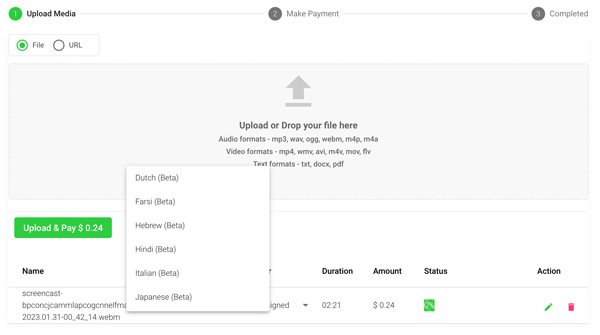
Once you have your audio or video file ready and load it into Speak, it will automatically calculate the total cost (you get 30 minutes free in the trial - take advantage of it!).
You can pay by subscribing to a personalized plan using our real-time calculator with included minutes.
You can also add a balance or pay for uploads without a plan using your credit card.
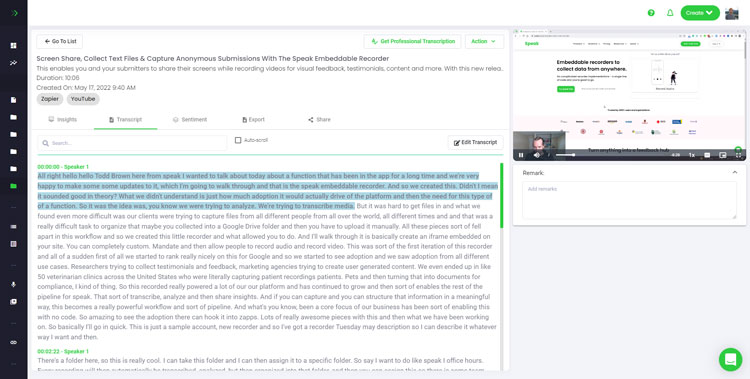
Our automated transcription software will prepare your transcript in as little as a few minutes. Generally, Speak takes about half the audio or video length to produce the transcript and insights.
Once completed, you will get an email notification that your transcript is complete. That email will contain a link back to the file so you can access the interactive media player with the transcript, analysis, and export formats ready for you.
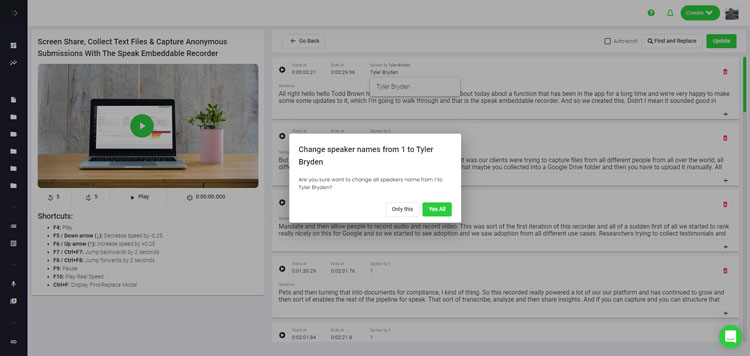
Want to tackle the transcript edits yourself? All good! Once you receive your automated transcript you have the option to edit your transcript at any time.
Easily update speaker names, find and replace, and get your automatic transcript up to full accuracy with our intuitive transcript editing system.
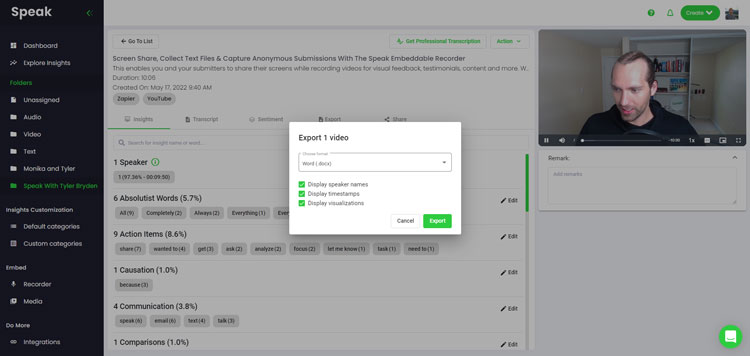
You can export your transcript in PDF, Word, TXT, HTML and even more advanced formats like CSV or JSON depending on your plan.
A more effective way of sharing transcripts is through a shareable media library that includes the media file, AI insights and an interactive transcript.
There is so much more that you can do with Speak to enrich the value of your media and transcripts.
Never hesitate to send us a message on live chat - we are always here to help!
We talked about transcription here, but you may be interested in how to transcribe in other languages instantly and easily with Speak's intuitive transcription and natural language processing software. We’ve shared resources below on all the languages Speak can help you transcribe!
Join 20,000+ users finding radical efficiencies with their audio, video and text data to drive value.
Speak offers highly competitive pricing for transcription compared to other transcription solutions. For a starting user, Speak offers automated transcription for only $0.06 USD per minute. That is only $3.6 USD per hour!
We also scale our pricing based on media volume and can offer even bigger discounts to large customers. So, if you have over 100 hours of transcription per month please contact us through live chat and we will set you up with a customized price per minute to make transcription even more affordable!
You can learn more about how to transcribe with Speak and the relevant pricing on the website pricing page and the in-app pricing page.
And so much more!
With Speak, you can easily export transcriptions to many formats.
Below is a list of options for exporting your transcripts in Speak:
If you are looking to subtitle in or caption in , Speak is a powerful solution. Speak’s automatic transcription software automatically generated transcripts with timestamps that enable Speak to quickly create SRT and VTT files necessary for captions and subtitles.
Speak already has users from over 90 countries and we continuously get requests to transcribe and analyze in different languages.
That brings us to 70+ languages in total offered which you can see below:
You can see the entire list of languages Speak supports through both the software and APIs.
Most automated transcription services are happy to just get you your transcript and send you on your way. But we always want to do more for you.
We found ourselves asking, "Now what?"
It's great that you have a transcript, but how do you now make that transcript valuable?
Here are a few tips on how you can go beyond just transcribing your MP4 to text by using Speak Ai:
Speak comes with built-in Natural Language Processing (NLP) and Sentiment Analysis which allows you to get better top level insights from your transcript.
You can use NLP to identify specific topics, names, brands and even set up custom vocabulary if you're transcribing content with uncommon words.
NLP is incredible helpful when it comes to quickly skimming through a transcript to find key information and can also inform marketing or content creation efforts by identifying important topics, keywords and brand mentions.
Sentiment Analysis is often used to get a general sense of the tone used throughout a recording. We currently identify three states - positive, neutral and negative - which allows you to navigate your transcript using tone and sentiment as an analysis point.
Sometimes simply sharing a text transcript is good enough, however at other times you want something more engaging for your viewers. A great way to create more interactive content experiences is with our SEO-friendly media players.
Generate individual media players for your transcribed file that include the audio clip, a clickable, interactive transcript as well as any insights you choose to display.
Make your media more meaningful by Including the main topics or keywords. This allows your audience to navigate to moments in the media that matter the most to them.
This improves on-page engagement as well as guaranteeing that users find the information they are looking for.
Content creation can be a frustrating process that takes much longer than we'd like. Did you know that transcripts are a quick solution to that?
If you don't have the time or capacity to create a blog post for every podcast, video or recording you have on your website, the easiest thing to do is just paste your transcript as-is on your website with the relevant media.
There are many benefits to this including increased on-page time, improved rankings for important keywords and you make sure that you're making your content accessible to a variety of users.
With Speak you can either do this manually by exporting your transcript in a format that works for you or you can set up an integration with your WordPress site.
Setting up the integration will allow you to seamlessly post your transcript on your website and edit it as a blog post with just one-click.
One of the best ways to improve your audio and video content to meet accessibility standards is to include subtitles and closed captions.
Not only can you convert your MP4 to text with Speak, but you can then choose to export that text as SRT or VTT files as well.
These files can be uploaded to YouTube or merged with your media file to create accessible content that can only do wonders for your content's performance.







Get a 7-day fully-featured trial.

Powered by Speak Ai Inc. Made in Canada with
Use Speak's powerful AI to transcribe, analyze, automate and produce incredible insights for you and your team.